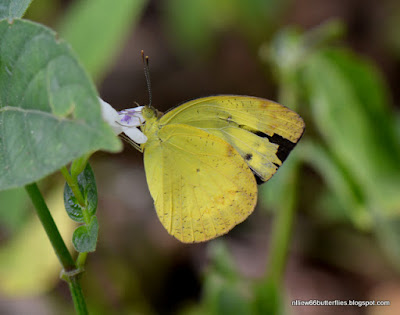The females can be mistaken for a very large Eurema nicevillei in flight because of the overall yellow uppersides with heavily dusted black wing margins and the yellow spots bordered with black on the forewing apex. The males are more variable, with different shades of lemon yellow to creamy off-white with a tinge of yellow on the uppersides of the wings and have more intense orange-yellow spots on the forewing apex much like the Great Orange Tip, Hebomoia glaucippe. On the undersides, they have a rather sullied overall yellow appearance because of mottling over a more drab yellow.
While males are commoner under the morning sun visiting flowering bushes and sunning themselves, females seem to be more discreet and prefer nectaring in shaded conditions. They seems to have an affinity for flowers of the Chinese Violet, Asystasia gangetica. Highly localised and rather scarce in lowland forest glades.
Habitat indicator
RSP
|
WV
|
PG
|
VF
|
FTR
|
SC
|
LWDF
|
LWPF
|
LMEF
|
UMN
|
MN
|
X
|
X
|
Frequency observation chart: (S marks the usual
occurences, H marks an unusually high occurence, F for first record)
2016
|
|||||||||||
Jan
|
Feb
|
Mac
|
Apr
|
May
|
Jun
|
Jul
|
Aug
|
Sep
|
Oct
|
Nov
|
Dec
|
S17(F)
|
|||||||||||
2017
|
|||||||||||
Jan
|
Feb
|
Mac
|
Apr
|
May
|
Jun
|
Jul
|
Aug
|
Sep
|
Oct
|
Nov
|
Dec
|
S17
|
S17
|
||||||||||
An all yellow female taking a rest after being disturbed while nectaring under sun-speckled forested trunk road glades: 08 Oct 2016 @ 16:46. They are commoner towards the late afternoon, nectaring on flowers when the males would have roosted.
Another female came out in the earlier part of a sunny morning to look for nectar: 09 Oct 2016 @ 10:16.
Towards late morning when the sun gets hotter, males come out to nectar and sun themselves on sunny bushes on the forest's edge. Above photos 09 Oct 2016 @10:47
10:51
10:51
Above pictures of a rather small male which was yellower on the uppersides.
10:57














No comments:
Post a Comment